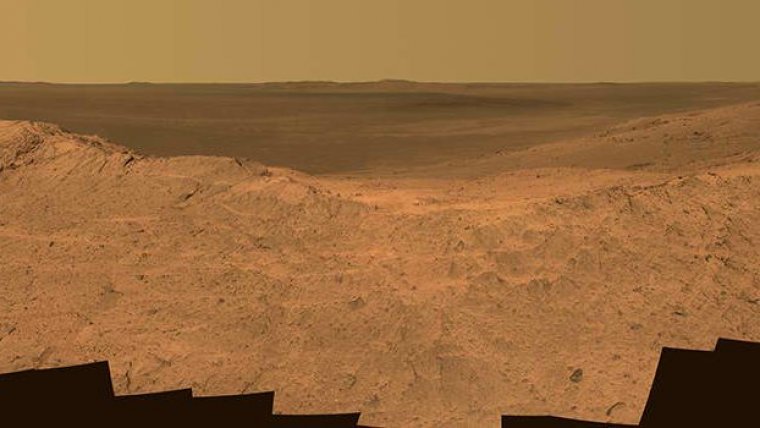| News / Space News |
Aluminum-Bearing Site on Mars Draws NASA Visitor
NASA | JUNE 26, 2014
With its solar panels their cleanest in years, NASA's decade-old Mars Exploration Rover Opportunity is inspecting a section of crater-rim ridgeline chosen as a priority target due to evidence of a water-related mineral.

This scene from the panoramic camera (Pancam) on NASA's Mars Exploration Rover Opportunity catches "Pillinger Point," on the western rim of Endeavour Crater, in the foreground. Image Credit: NASA/JPL-Caltech/Cornell Univ./Arizona State Univ.
Orbital observations of the site by another NASA spacecraft, Mars Reconnaissance Orbiter, found a spectrum with the signature of aluminum bound to oxygen and hydrogen. Researchers regard that signature as a marker for a mineral called montmorillonite, which is in a class of clay minerals called smectites. Montmorillonite forms when basalt is altered under wet and slightly acidic conditions.
The exposure of it extends about 800 feet (about 240 meters) north to south on the western rim of Endeavour Crater, as mapped by the orbiter's Compact Reconnaissance Imaging Spectrometer for Mars (CRISM).
Some of the most important findings from Opportunity's long mission came from combining CRISM and rover observations of a site about 2 miles (3 kilometers) farther north on the crater's western rim.
Rocks exposed there contain evidence for an iron-bearing smectite - called nontronite -- as well as for montmorillonite. That site yielded evidence for an ancient environment with water that would have been well-suited for use by microbes, if Mars had any billions of years ago.
Evidence that Opportunity may add about the geological context for different smectites could boost understanding about diversity and changes in ancient wet environments on Mars.
Opportunity reached the northern end of the montmorillonite-bearing exposure last month, at a high spot called "Pillinger Point."
Though selected as a science destination, Pillinger Point also offers a scenic vista from atop the western rim of Endeavour Crater, which is about 14 miles (22 kilometers) in diameter.
Initial measurements at this site with the element-identifying alpha particle X-ray spectrometer at the end of Opportunity's arm indicate that bright-toned veins in the rock contain calcium sulfate. Scientists deduce this mineral was deposited as water moved through fractures on Endeavour's rim. The rover earlier found veins of calcium sulfate farther north along the rim.
YOU MAY ALSO LIKE

